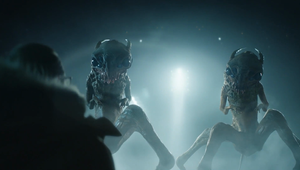
It’s All Just Pixels, or Is It?

Questions of Reality
In an epic and playful moment, a subway train adorned with giant eyelashes pulls into a tube station and gets a touch-up from a colossal mascara brush. Does it matter if this didn’t happen in the physical world “for real”?
A cookie brand builds a vault in Norway to safeguard their baked goods against the possibility of a rogue asteroid. Most of us will only ever see the vault on our screens. Does it matter if the structure was built in the physical world with great effort and expense? A famous actor does his own stunts. Should this impact our enjoyment of his films?
In other words, what is the relationship between what occurs in the real world and what comes to us through the world of our screens?
A Thought (Experiment)
Imagine you have been hired by a luxury-car company to make a film celebrating the brand’s 75th anniversary. You stack 75 cars (one from each model year) on top of each other to create an epic sculpture that, when the sun rises on the exact anniversary of the birth of the company, creates a shadow in the shape of the company logo. (Note: The cars’ stackability is not a selling point.) You travel to a remote location, build the menhir, and capture the moment of sunrise in an intricate, single-take drone shot. Pretty epic.
Or…
You create the same scene on a computer.
If the CGI approach and the physical approach are indistinguishable on a phone screen, is there a difference between them? If everything just ends up on a screen, should we care if it first existed in the physical world? As advertisers who create stories and images that go on screens, this is not just a philosophical question, it’s a practical one that resurfaces with every new iteration of technology.
(An Attempt at) an Answer
The “Mona Lisa” and an exact copy of the “Mona Lisa” may look the same, but they are not the same thing. One was created by Leonardo da Vinci, and one was not. The creation of the work is an inseparable part of the meaning of the work itself [Walter Benjamin writes about this as the aura]. The effort it took to make the project, the time, the money, and the planning are all, to some degree, embedded in the final work. We cannot separate the final result from this parallel story, which is the process of making it. If the cookie vault were made in Photoshop, it would be a very different project, and if our mascara brush existed in the physical world, it would not be the same thing. We are not creating a hierarchy, but we must acknowledge that where the pixels came from makes a difference and it is a part of the story whether we foreground it or not.
But what does this mean for us?
We have to ask ourselves, “What kind of story is our brand telling?” Do we want our audience to get lost in the playful fiction of the idea or awed by the physical scope of the work?
If it’s the first approach, and our brand is embracing the GLGB (Getting Lost in a Good Book) philosophy, we don’t need to be tethered to the constraints of the physical world. We can imagine your brand as a captivating book where people can get lost, meeting others who share similar interests and connecting to the brand. This shared sense of fun and whimsy doesn’t need to happen “for real.” The fun is the fiction. The fun is getting swept away into this imaginative world, and the CGI approach doesn’t undercut the joy of the experience.
On the other hand, if we are trying to inspire or wow the audience with the audacity of the undertaking, then we have to do it for real. This is especially important if the brand is built on authenticity. We have to stack the cars or build the vault, because that physicality and the quixotic effort that it entails are an important part of the story. Part of the fun of the project is the scope and size, and our audience will feel betrayed if we don’t bring the epic event to the real world.
So, in the end, the key thing to remember is that even if everything ends up as pixels, it always starts with the brand, and story of the brand will tell us the best approach to take.













